Performance testing overview
Our testing is a little different than most. We combine both synthetic and real-world applications to simulate the types of performance common to the individual products. For motherboards this means that we run roughly six synthetic tests and two real-world. We will be expanding the real-world testing in the near future. But there is more to performance than just the raw numbers. As there are multiple components and sub-components on a motherboard there each item can have a distinct impact on the way the product will perform once you get it in your system. It is important to note not only the actual results but what they mean to you as a potential consumer. We will try to give this information to you. But we do not just cover the performance aspects that are measurable. We also talk about the components that might not have a direct benchmark. These are items like Audio Quality, ease of use and installation. *As a note the H55N shown in these graphs was using an Intel Core i7 875K and an HD 5970. I included it only as an afterthought; it was interesting to see the numbers in comparison especially the gaming numbers.
Section 1 Subsystems
Memory -
Memory performance is very important on a motherboard, especially when you have a CPU with multiple cores and threads. If you have slow memory your cores and threads can become starved for data to execute. To test memory performance we run both Sisoft’s SANDRA and Everest Ultimate. These two combine to not only give us accurate numbers but to validate each other. For testing at stock speeds the memory is hard set to 1333MHz while overclocking testing is done at the highest stable speed for the voltage of 1.65v this is due to the different memory dividers for each CPU. As such, the memory speeds will vary greatly. This means that the overclocked numbers are a little misleading and while they can show a trend are really only included to show if a board has a problem with memory performance at high clockspeeds.
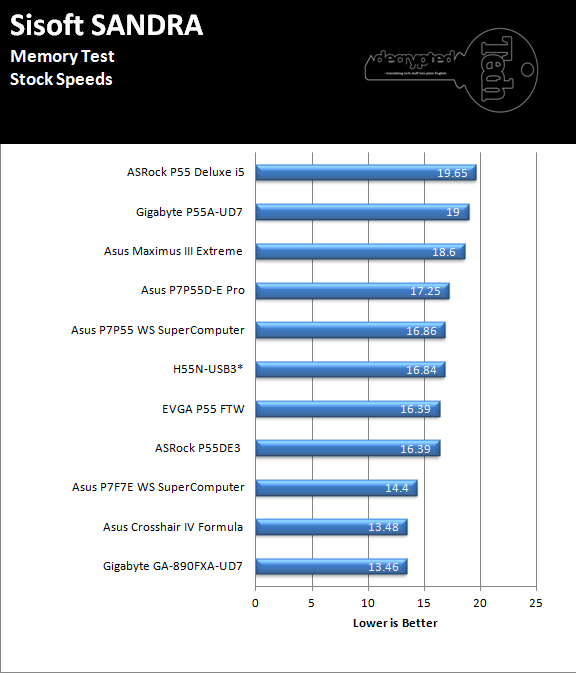 |
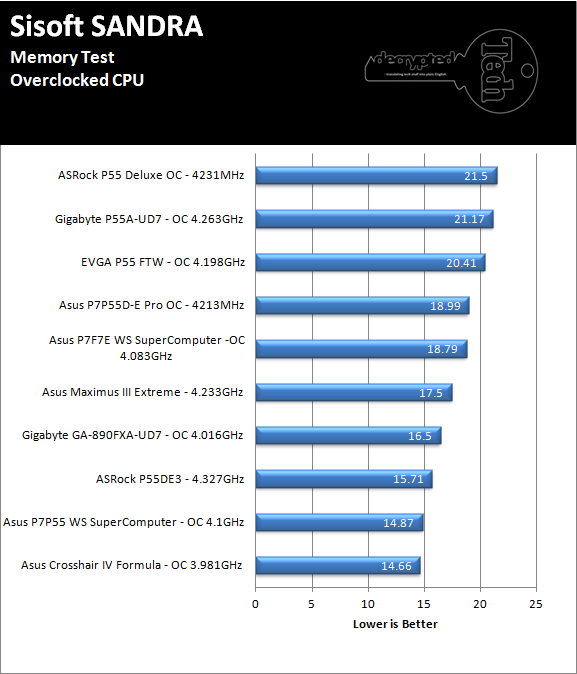 |
As we mentioned above AMD CPUs in particular have some memory speed issues. It revolves around an issue inherent with AMD’s IMC design. Going all the way back to the original Athlon CPU AMD has had performance issues with higher latency RAM. This issue became even more evident with the release of the AM2 and the reliance on higher speed, but lower latency DDR2. Now in the age of DDR3 we find the same problem. You can counter this by pushing the latency down often sacrificing actual memory clock speed. However none of that helps us with the current hardware we used.
 |
 |
Everest shows us again that AMD CPUs are not memory efficient. This is not a fault of Gigabyte, but one that systemic the chipset and CPU used. If there is not something to counter balance this performance hit then we might see poor scores in the rest of our tests.
Drive performance -
Drive performance is also one of the major subsystems that goes to make up the performance of a motherboard. For our testing we use Sandra and Everest again. We only test with single drives for each type of controller present on the motherboard (unless it is a professional product where we will use RIAD 5 and/or 10). We have also begun using a Seagate PS-110 USB 3 external HDD for our USB 3.0 performance. As a side note, we include the overclocked numbers here to make sure (again) that you are not going to see a major drop in performance due to minor instabilities at high clock speeds.
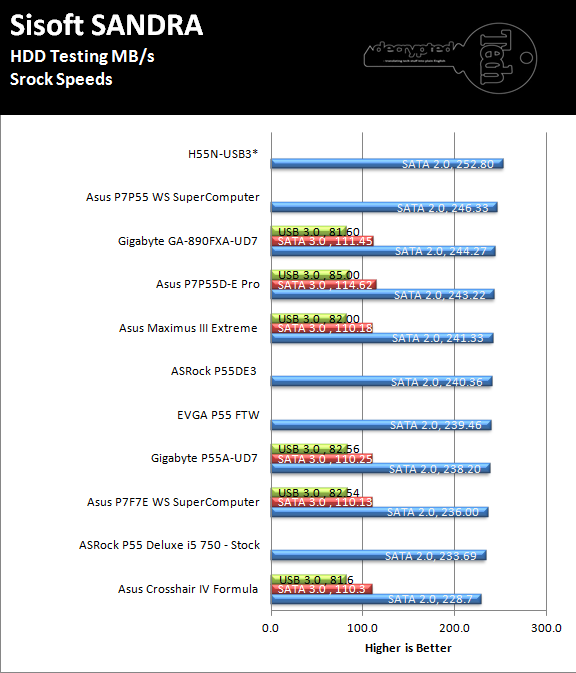 |
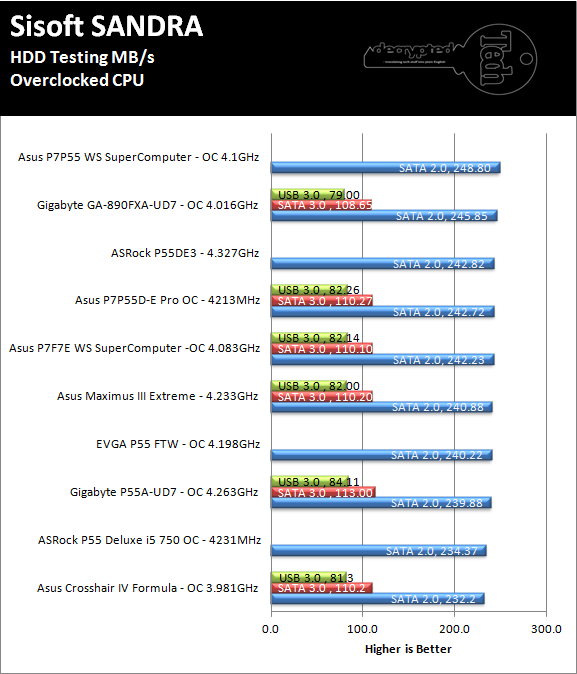 |
The HDD performance on the 890FXA-UD7 is very good, it is right up at the top of the scale here. It even tops out many of the Intel ICH10R controllers which are usually very fast.
 |
 |
 |
 |
Everest confirms our findings from Sandra and backs up the fact that you can expect some excellent performance in terms of drive speed. This could balance out the memory performance issues that we saw above and allow us to still get some good scores in our testing suite.
Power -
Power efficiency is another of those misnomers that we get caught up in. We hear about idle states and power gates. But what does that mean to you and I? On the surface having power management that reduces idle power sounds great and can be a benefit to someone that leaves their system on for long periods of time (and inactive) but how a system handles power under load and the delta between the two states is often more important than the idle power usage numbers. We use only P3 Kill A Watt instruments for measuring power.
 |
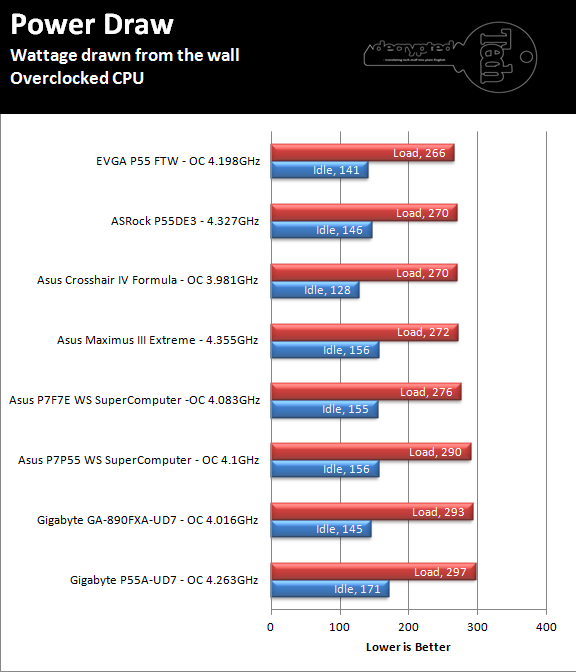 |
The 890FXA draws quite a bit of power when you make it work for you. It is not so bad at idle, but then again what a product does while idle is not as important as how well it delivers power under pressure. The dramatic delta here is concerning but it is not too far out of the ordinary. Interestingly enough when we overclock the CPU the 890FXA-UD7 does not draw much more power than it did at stock speeds.
Cooling (Board Level)
Board level cooling is an important factor in product performance and longevity. Components like the chipset, VRM modules and even capacitors need to be kept relatively cool to prevent failure. As these parts are made of silicon, they have a thermal breakdown threshold; or melting point. At that temperature the actual transistors built into chip will begin to deform and break down. Granted, the threshold is often very high, but you still need to make sure that components stay away from this level of heat for longer product life.
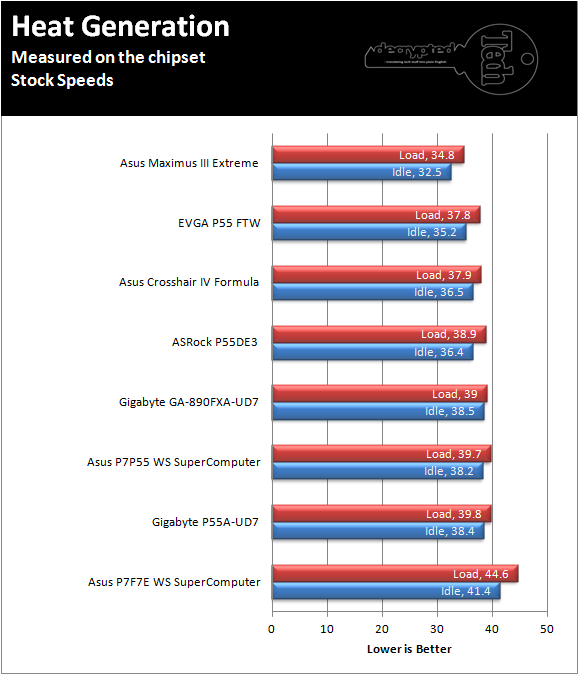 |
 |
Conversely the cooling on the 890FXA-UD7 was quite good. It also had one of the lowest deltas between idle and load out of all the boards we have tested in this group. This is good as it reduced wear on the components which provides for longer product life and also reduces wear on the rest of the system.
Audio -
Audio is highly subjective. What we find pleasing may sound “off” to you. That is always going to the problem with testing audio; results will vary too widely depending on the tastes of the listener. However, there are ways of measuring the audio output with an objective ear. There is also the issue of audio causing performance issues in gaming and video playback. The reason this is a potential source of concern is that all onboard audio CODECs (Compression/Decompression) are CPU controlled. This means that while the audio chip controls the audio levels and effects of the audio the actual work is done on the CPU. Usually this will not be a problem with today’s powerful CPUs. Even the lower and consumer level products can handle high-end audio these days. But again there is the chance that a bad design or software will hinder your system and performance. On the other side the limits of board space, cost, etc will also prevent the level of audio quality you can get from an add-in board. We test all audio parts with three media types, Movie (DVD), MP3 Music, and Gaming. These are pushed to our Tec On model 55 Tube Amp to see if we can detect any signal issues in the reproduction.
The audio on the 890FXA was acceptable; it was nothing out of the ordinary for a high-end motherboard (powered by a Realtek ALC889 audio CODEC). If you are looking for high-end audio I would recommend getting an add-in board. Of course this does not take away from the boards overall quality, like I said the audio is acceptable, you can get good gaming sounds from it and for most music playback it is more than enough. It is just not going to win any awards.
Networking -
This one is something that is a requirement anymore. If you have a computer, the chances are good (like 99%) that you are also connected to high-speed internet. With this you need a good and solid LAN chip to make sure that your data flows properly out and back.
The networking on the 890FXA is powered by a pair of Realtek 8111D GBe LAN chips these have support for direct teaming and can be set in a number of configurations. One of the most popular is simply to combine them to double your bandwidth. This is a great feature if you are using the 890FXA for a media server, or are at a LAN party that supports teamed networking. However for most home networks it will be of little use. Still it is a nice touch.




